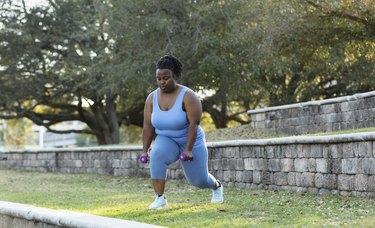
A workout doesn't have to be long to be effective. In fact, a super short, push-to-your-limits sweat session can kick your butt far better than a steady-state effort sometimes.
And that's where Tabata training comes in. If you've been wondering what Tabata is, the possible benefits of this type of workout and how to put together a Tabata training session, here's what you need to know.
Video of the Day
What Is Tabata Training?
"Tabata is classified as a type of HIIT workout," fitness educator and certified personal trainer Lauren George, CPT, tells LIVESTRONG.com. (HIIT stands for high-intensity interval training.) "But Tabata is considered one of the most difficult types," she says.
Here's why: When you perform a HIIT workout, you're going to do periods of "work" (where you perform an exercise), followed by a period of "recovery" (where you slow down or rest completely). This is your work-to-recovery (or work-to-rest) ratio. HIIT can take on many forms. You can have a 2:1 or 1:1 work-to-recovery ratio. So, you might run hard on a treadmill for 1 minute and then slow down to a fast walk for 1 minute; this would be a 1:1 work-to-recovery ratio.
On the other hand, Tabata is very specific. Developed by Japanese scientist Izumi Tabata in 1996, Tabata training involves a 20-second work period with 10 seconds of rest. The idea is that you go "all out" (whatever that means for you at your fitness level) for the 20-second period and then recover for 10 seconds. This is repeated for a total of 8 rounds.
Yes, that means an entire Tabata is just 4 minutes long — but because it's high-intensity, you'll be breathless by the end. Practically speaking, you also don't have to count reps, so it's a nice mental break, too, George says.
The Benefits of Tabata Workouts
"Tabata is one of the most popular workouts in my virtual studio, especially for people who work out at home. It's efficient and effective," George says.
That said, because you move at a speed that is challenging for you, Tabata is accessible to all fitness abilities. "There's a stigma that you have to be super in shape to do Tabata, but that's not true," George says.
Julie Jones, CPT, certified personal trainer and founder of Julie Jones Fitness, adds that a Tabata workout allows you to test your limits. And, it's perfect for a busy schedule. "Tabata is a great way to get in a workout in a short period of time. I like to use it as a way to challenge my body to work harder than normal and push my endurance power level," she tells LIVESTRONG.com.
Though one Tabata is 4 minutes long, you might choose to string several together for a full 20-minute session (follow along with a sample workout below). Make sure to rest completely in between sets.
What's more, Tabata can be a full-body cardio exercise with some strength added in, making it a well-rounded workout, Jones says. The fast nature of pushing yourself during the 20-second bout of work will increase your heart and respiratory rate to improve cardiovascular health. So, if you have just 4 minutes to exercise on a given day, one Tabata session is still worth doing!
However, if you make some of the exercises within the workout resistance-based, you'll also improve your muscle strength, too. "You can use Tabata to create progressive overload and thus hypertrophy [growth] in muscles, so that muscle break down and rebuild stronger," George says.
The Best Tabata Exercises
How do you structure a Tabata workout? Here are two common ways you'll see Tabata workouts formatted, and it's really up to you which one you want to choose on a given day.
- A/B: Choose two exercises (more on that below) to alternate between. You'll do each exercise four times.
- A/B/C/D: Choose four exercises (more on that below) to move though. You'll do each exercise two times.
Traditional cardio, plyometric and strength moves can all be incorporated into Tabata. "There is a lot of flexibility in the workout, so you can focus it all on cardio or body-weight strength training if you'd like, or mix it up," Jones says.
Whichever exercises you choose, make sure you understand the mechanics of how to do them and the right form before attempting to do them in a Tabata workout where you'll be moving very quickly, she says. Otherwise, there's the potential for injury.
Here are sample Tabata exercises you can include in a workout:
- Push-up
- Triceps dip
- Mountain climber
- Tuck jump
- Burpee
- High knees
- Body-weight squat
- Body-weight lunge
- Lunge jump
- Jump squat
- Jumping jack
- Jump rope
- Speed skater
- Box jump
In addition, it's possible to make your exercise session more strength-based by incorporating weights, George says. A few exercise ideas:
- Clean and press
- Dumbbell snatch
- Front squat
- Alternating reverse lunge
- Push-up to mountain climber
- Biceps curl
You can do these moves with heavy enough weights where you become breathless moving through them, but not so heavy as to compromise your form, George says.
A Sample Tabata Workout to Try
When choosing exercises, Jones recommends fitting in a mix of intensities, which allows you to keep up with the workout and maintain good form. (For example, you might want to do high knees and push-ups as your A/B rather than tuck jumps and jumping lunges.)
To know if you're going hard enough, you shouldn't be able to conduct a conversation during the work portion. Because this is HIIT, allow your body one or two days of rest in between sessions for adequate recovery, Jones suggests. In addition, Tabata fits into a well-rounded exercise routine that includes traditional resistance training with steady-state cardio, she says.
Before you start, download a Tabata app (like this one) so you know when the 20- or 10-second period is up (and when to start again). You can also use a stopwatch (or the stopwatch function on your phone) to keep time, Jones says.
Jones developed the following four-move Tabata workout. Perform each exercise below for 20 seconds, then rest for 10 seconds before moving onto the next exercise. Complete 2 rounds for a total of 4 minutes of work.
1. Jump Squat
- Stand with your feet shoulder-width apart and your toes facing forward or slightly outward.
- Keeping your feet flat on the floor and back straight, brace your core and push your hips back and down until your thighs are parallel to the floor (or as low as you can comfortably go).
- From the bottom of your squat, push through your feet to jump explosively off the ground. (You can extend your arms down along your sides as you do.)
- Land safely with your knees slightly bent.
2. Push-Up
- Position yourself on your hands and knees, hands under shoulders and knees under hips.
- Step your feet back and straighten your legs so that you're balanced on your palms and toes.
- Check your body and hand position: Your body should make a straight line from head to hips to heels, and your hands should be directly under your shoulders or slightly wider apart.
- Bend your elbows at a 45-degree angle to your body and lower your body to the floor.
- Make sure to keep your body in one straight line from the neck through the spine to the hips and down to the heels.
- Press into your palms and push the floor away from you to come back up to a high plank, still keeping your body in one straight line.
3. Mountain Climber
- Position yourself on your hands and knees, hands under shoulders and knees under hips.
- Step your feet back and straighten your legs so that you're balanced on your palms and toes.
- Check your body and hand position: Your body should make a straight line from head to hips to heels, and your hands should be directly under your shoulders or slightly wider apart.
- Bring your right knee into your chest, engaging your abs at the same time.
- Return your right knee to starting position.
- Bring your left knee into your chest, then shoot it back, switching legs at your desired pace.
4. Jump Lunge
- Stand with your feet shoulder-width apart, then jump your right leg forward and your left leg back, landing in a lunge position — both knees bent to 90 degrees.
- Jump again, switching your legs mid-air so you land in a lunge with your left leg in front and your right leg in back.
- Continue to jump back and forth as smoothly and quickly as possible.
An Advanced 20-Minute Tabata Workout
Want to try out a longer Tabata workout? Below, George talks you through a routine she created, so turn up the volume and follow along! All you need is a mini band and a pair of dumbbells to get started.
Follow along with the video above for how to do this workout!


